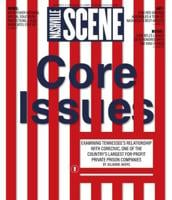
Alyssa Weddle
Having sickle cell disease used to mean Alyssa Weddle missed out on normal teenage things — going out with friends, school work, extracurricular activities. Now, after gene editing therapy, it’s been more than two years since the 16-year-old has been hospitalized for pain caused by sickle cell disease.
Weddle took part in a clinical trial for CRISPR-Cas9 gene-editing therapy at TriStar Centennial beginning in 2021.
In early December, CRISPR-Cas9 gene editing therapy was approved by the Food and Drug Administration for the treatment of sickle cell in patients ages 12 and up. It’s the first FDA approval for the gene-editing therapy, whose creators won the Nobel Prize in chemistry in 2020.
The lead investigator for the clinical trial is Dr. Haydar Frangoul, director of pediatric hematology/oncology for the Sarah Cannon Pediatric Transplant and Cellular Therapy Program at TriStar Centennial. He tells Scene sister publication the Nashville Post that TriStar Centennial has hosted the largest number of patients as part of the national trial, including the first patient, who was treated mid-2019.

Haydar Frangoul
Sickle cell is an inherited blood disorder that mostly affects those who are of African ancestry. About one in every 365 Black or African American babies is born with sickle cell disease.
For those with the disease, hemoglobin, which transports oxygen in red blood cells, is rigid instead of liquid. Because of this, their blood cannot effectively transport oxygen to the organs, damaging them. That damage shortens the patient’s lifespan to around 50 years. It can also cause pain crises like those that would send Weddle to the hospital, where sometimes she would have to stay for a week just to have access to pain management.
“It’s all you can focus on, and sometimes if I had pain in my back I wouldn’t be able to walk,” she says. “It affects everything when I’m having a pain crisis.”
Frangoul explains there are some people who have sickle cell disease but do not experience any symptoms. Those people have what is called hereditary persistence of fetal hemoglobin, something that all infants have, though most people’s blood switches over to adult hemoglobin at around 6 months old.
Physicians collect stem cells, edit them back to the fetal hemoglobin, and infuse them into the patient intravenously, leaving them with around 40 percent fetal hemoglobin — like a 1-month-old, or like those with hereditary persistence.
“After we have published our work and talked about it, people are doing more and more clinical trials for other diseases using the same technology,” Frangoul says. “It's huge. Basically, you talk about astronomy landing on the moon — this is landing on the moon in human genetics.”
Gene-editing therapy is, however, an arduous process for the patient. Weddle underwent chemotherapy to suppress existing immune cells so the new cells could expand more effectively. She spent a month in the hospital and had her eggs frozen, as chemo can affect fertility.
“It was kind of scary to do those procedures and have to think about having kids and doing all that at such a young age, but I was excited because it felt really real and it felt like I actually had a chance to not have sickle cell,” Weddle says.
Before the CRISPR technology, the only cure for sickle cell patients was a bone marrow transplant from a sibling who was a blood match but did not have the disease. Around 15 percent of patients have a sibling match, leaving 85 percent without a cure. That’s been the norm for more than 25 years, Frangoul says.
Not all patients will be able to take the treatment. Frangoul says patients whose organs are already too damaged would not benefit from the process. The hope is to treat patients as young as possible before organ damage.
Another hitch: Insurance companies have just started to cover the therapy, and patients who are uninsured will struggle to afford the expensive treatment.
“I'm hoping that insurance companies will look at this and say the benefit of this therapy way outweighs the cost for it because you're changing patients' lives,” Frangoul says.
In the next 10 years, Frangoul anticipates doctors will be able to edit cells without removing them from the body or using chemotherapy. But for now, Weddle and the other patients who took part in the clinical trial at TriStar can live a normal life.
“I’m going to get my [driver’s] license and focus on me and what I want to do for my future, not having to think about randomly going into a pain crisis or being in the hospital,” Weddle says. “I’m just excited that I kind of get to start my life over again and learn what it’s like to be a normal teenager and to go out with friends and go to a pool party and do all of that.”
This article was first published by our sister publication, the Nashville Post.






